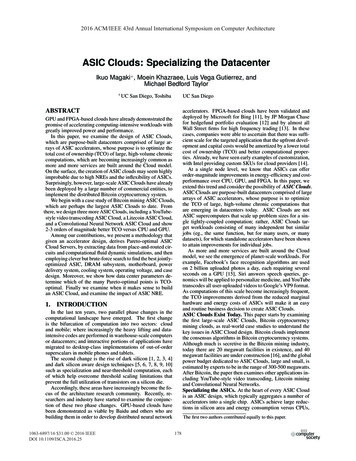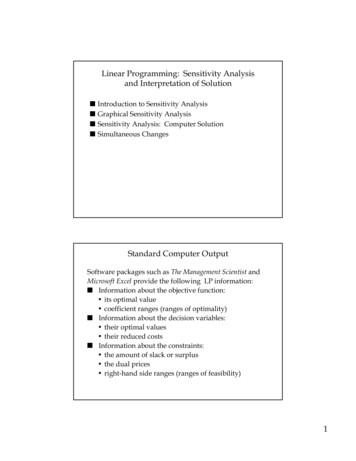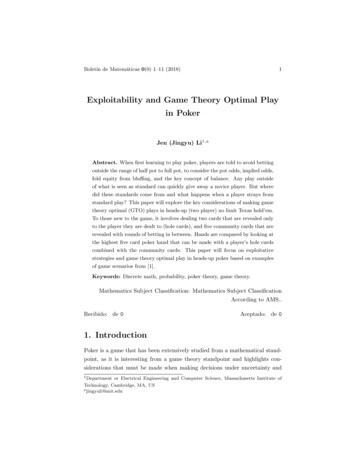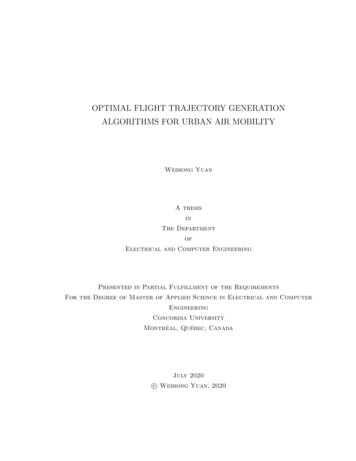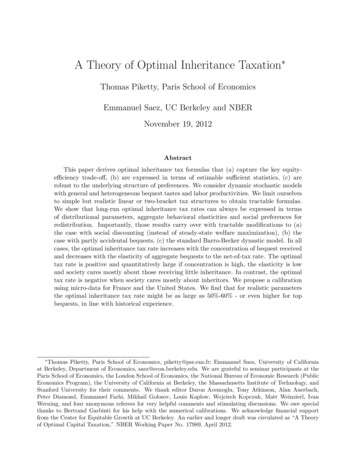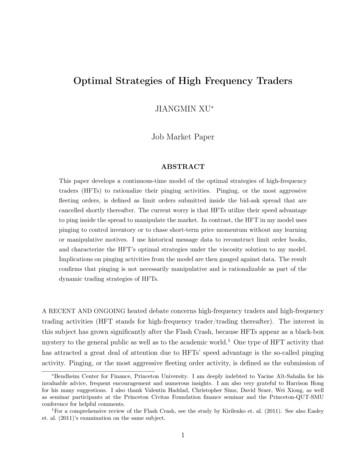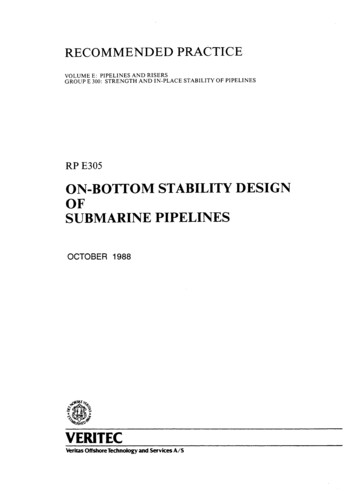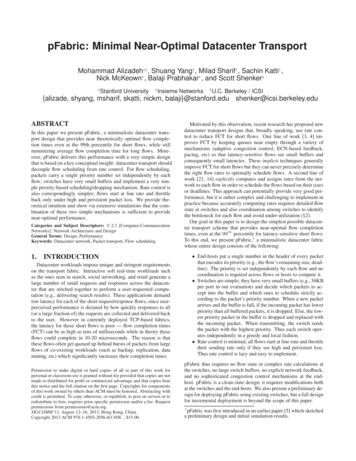
Transcription
pFabric: Minimal Near-Optimal Datacenter TransportMohammad Alizadeh†‡ , Shuang Yang† , Milad Sharif† , Sachin Katti† ,Nick McKeown† , Balaji Prabhakar† , and Scott Shenker§†Stanford University‡Insieme Networks§U.C. Berkeley / ICSI{alizade, shyang, msharif, skatti, nickm, balaji}@stanford.edu shenker@icsi.berkeley.eduABSTRACTIn this paper we present pFabric, a minimalistic datacenter transport design that provides near theoretically optimal flow completion times even at the 99th percentile for short flows, while stillminimizing average flow completion time for long flows. Moreover, pFabric delivers this performance with a very simple designthat is based on a key conceptual insight: datacenter transport shoulddecouple flow scheduling from rate control. For flow scheduling,packets carry a single priority number set independently by eachflow; switches have very small buffers and implement a very simple priority-based scheduling/dropping mechanism. Rate control isalso correspondingly simpler; flows start at line rate and throttleback only under high and persistent packet loss. We provide theoretical intuition and show via extensive simulations that the combination of these two simple mechanisms is sufficient to providenear-optimal performance.Categories and Subject Descriptors: C.2.1 [Computer-CommunicationNetworks]: Network Architecture and DesignGeneral Terms: Design, PerformanceKeywords: Datacenter network, Packet transport, Flow scheduling1.INTRODUCTIONDatacenter workloads impose unique and stringent requirementson the transport fabric. Interactive soft real-time workloads suchas the ones seen in search, social networking, and retail generate alarge number of small requests and responses across the datacenter that are stitched together to perform a user-requested computation (e.g., delivering search results). These applications demandlow latency for each of the short request/response flows, since userperceived performance is dictated by how quickly responses to all(or a large fraction of) the requests are collected and delivered backto the user. However in currently deployed TCP-based fabrics,the latency for these short flows is poor — flow completion times(FCT) can be as high as tens of milliseconds while in theory theseflows could complete in 10-20 microseconds. The reason is thatthese flows often get queued up behind bursts of packets from largeflows of co-existing workloads (such as backup, replication, datamining, etc) which significantly increases their completion times.Permission to make digital or hard copies of all or part of this work forpersonal or classroom use is granted without fee provided that copies are notmade or distributed for profit or commercial advantage and that copies bearthis notice and the full citation on the first page. Copyrights for componentsof this work owned by others than ACM must be honored. Abstracting withcredit is permitted. To copy otherwise, or republish, to post on servers or toredistribute to lists, requires prior specific permission and/or a fee. Requestpermissions from permissions@acm.org.SIGCOMM’13, August 12–16, 2013, Hong Kong, China.Copyright 2013 ACM 978-1-4503-2056-6/13/08 . 15.00.Motivated by this observation, recent research has proposed newdatacenter transport designs that, broadly speaking, use rate control to reduce FCT for short flows. One line of work [3, 4] improves FCT by keeping queues near empty through a variety ofmechanisms (adaptive congestion control, ECN-based feedback,pacing, etc) so that latency-sensitive flows see small buffers andconsequently small latencies. These implicit techniques generallyimprove FCT for short flows but they can never precisely determinethe right flow rates to optimally schedule flows. A second line ofwork [21, 14] explicitly computes and assigns rates from the network to each flow in order to schedule the flows based on their sizesor deadlines. This approach can potentially provide very good performance, but it is rather complex and challenging to implement inpractice because accurately computing rates requires detailed flowstate at switches and also coordination among switches to identifythe bottleneck for each flow and avoid under-utilization (§2).Our goal in this paper is to design the simplest possible datacenter transport scheme that provides near-optimal flow completiontimes, even at the 99th percentile for latency-sensitive short flows.To this end, we present pFabric,1 a minimalistic datacenter fabricwhose entire design consists of the following: End-hosts put a single number in the header of every packetthat encodes its priority (e.g., the flow’s remaining size, deadline). The priority is set independently by each flow and nocoordination is required across flows or hosts to compute it. Switches are simple; they have very small buffers (e.g., 36KBper port in our evaluation) and decide which packets to accept into the buffer and which ones to schedule strictly according to the packet’s priority number. When a new packetarrives and the buffer is full, if the incoming packet has lowerpriority than all buffered packets, it is dropped. Else, the lowest priority packet in the buffer is dropped and replaced withthe incoming packet. When transmitting, the switch sendsthe packet with the highest priority. Thus each switch operates independently in a greedy and local fashion. Rate control is minimal; all flows start at line-rate and throttletheir sending rate only if they see high and persistent loss.Thus rate control is lazy and easy to implement.pFabric thus requires no flow state or complex rate calculations atthe switches, no large switch buffers, no explicit network feedback,and no sophisticated congestion control mechanisms at the endhost. pFabric is a clean-slate design; it requires modifications bothat the switches and the end-hosts. We also present a preliminary design for deploying pFabric using existing switches, but a full designfor incremental deployment is beyond the scope of this paper.1pFabric was first introduced in an earlier paper [5] which sketcheda preliminary design and initial simulation results.
The key conceptual insight behind our design is the observation that rate control is a poor and ineffective technique for flowscheduling and the mechanisms for the two should be decoupledand designed independently. In pFabric, the priority-based packetscheduling and dropping mechanisms at each switch ensure that itschedules flows in order of their priorities. Further, the local andgreedy decisions made by each switch lead to an approximately optimal flow scheduling decision across the entire fabric (§4.3). Onceflow scheduling is handled, rate control’s only goal is to avoid persistently high packet drop rates. Hence, the rate control design getscorrespondingly simpler: start at line rate and throttle only if bandwidth is being wasted due to excessive drops.We evaluate our design with detailed packet-level simulationsin ns2 [15] using two widely used datacenter workloads: one thatmimics a web application workload [3] and one that mimics a typical data mining workload [12]. We compare pFabric with fourschemes: an ideal scheme which is theoretically the best one coulddo, the state-of-the-art approach for datacenter transport, PDQ [14],as well as DCTCP [3] and TCP. We find that: pFabric achieves near-optimal flow completion times. Further, pFabric delivers this not just at the mean, but also at the99th percentile for short flows at loads as high as 80% of thenetwork fabric capacity. pFabric reduces the FCT for shortflows compared to PDQ and DCTCP by more than 40% and2.5–4 respectively at the mean, and more than 1.5–3 and3–4 respectively at the 99th percentile. With deadline driven workloads, pFabric can support a muchlarger number of flows with deadlines as well as much tighterdeadlines compared to PDQ. For instance, even for deadlineswhere the slack with respect to the lowest possible FCT isonly 25%, pFabric meets the deadline for 99% of the flows(about 2 more than PDQ) at 60% network load. If the network designer has detailed knowledge of the flowsize distribution in advance and carefully tunes parameterssuch as the flow size thresholds for each priority queue, minimum buffer per priority queue, etc pFabric can be approximated using existing priority queues in commodity switches.This approach provides good performance too, but we findthat it is rather brittle and sensitive to several parameters thatchange in a datacenter due to flow and user dynamics.2.RELATED WORKMotivated by the shortcomings of TCP, a number of new datacenter transport designs have been proposed in recent years. Webriefly contrast our work with the most relevant prior work. Asdiscussed earlier, broadly speaking, the previous efforts all use ratecontrol to reduce flow completion time.Implicit rate control: DCTCP [3] and HULL [4] try to keep thefabric queues small or empty by employing an adaptive congestioncontrol algorithm based on ECN and other mechanisms such as operating the network at slightly less than 100% utilization, packetpacing, etc to appropriately throttle long elephant flows. Consequently, the latency-sensitive flows see small buffers and latencies. D2 TCP [18], a recently proposed extension to DCTCP, addsdeadline-awareness to DCTCP by modulating the window size basedon both deadline information and the extent of congestion. Whilethese schemes generally improve latency, they are fundamentallyconstrained because they can never precisely estimate the right flowrates to use so as to schedule flows to minimize FCT while ensuring that the network is fully utilized. Furthermore, due to the burstynature of traffic, keeping network queues empty is challenging andrequires carefully designed rate control and hardware packet pacingat the end-hosts and trading off network utilization [4].Explicit rate control: Having recognized the above limitations,subsequent work explicitly assigns a sending rate to each flow inorder to schedule flows based on some notion of urgency. The assigned rates are typically computed in the network based on flowdeadlines or their estimated completion time. D3 [21] first proposed using deadline information in conjunction with explicit ratecontrol to associate rates to flows. D3 allocates bandwidth on agreedy first-come-first-served basis and does not allow preemptionsand has thus been shown to lead to sub-optimal flow schedulingsince a near-deadline flow can be blocked waiting for a far-deadlineflow that arrived earlier [14].The most closely related work to pFabric and in fact the stateof-the-art approach in this space is PDQ [14]. PDQ was the first topoint out that minimizing FCTs requires preemptive flow scheduling and attempts to approximate the same ideal flow schedulingalgorithm as pFabric to minimize average FCT or missed deadlines(§3). However, like D3 , PDQ’s flow scheduling mechanism is alsobased on switches assigning rates to individual flows using explicitrate control. In PDQ, on packet departure, the sender attaches ascheduling header to the packet that contains several state variablesincluding the flow’s deadline, its expected transmission time, andits current status such as its sending rate and round-trip-time. Eachswitch then maintains this state for some number of outstandingflows and uses it to decide how much bandwidth to allocate to eachflow and which flows to “pause”.PDQ provides good performance but is quite challenging andcomplex to implement in practice. Since the switches on a flow’spath essentially need to agree on the rate that is to be assigned tothe flow, PDQ needs to pass around state regarding a flow’s rate andwhich switch (if any) has paused the flow. Further, since switchesneed to be aware of the active flows passing through them, in PDQ,every flow must begin with a SYN and terminate with a FIN sothat switches can perform the required book-keeping. This one extra round-trip of latency on every flow may not be acceptable because most latency sensitive flows in datacenters are small enoughto complete in just one RTT.2 Thus, requiring the network to explicitly and efficiently assign a rate to each flow requires detailedflow state (size, deadline, desired rate, current rate, round-trip time,etc) at switches and also coordination among switches to identifythe bottleneck for each flow and avoid under-utilization. This is amajor burden, both in terms of communication overhead and requisite state at switches, particularly in the highly dynamic datacenterenvironment where flows arrive and depart at high rates and themajority of flows last only a few RTTs [12, 7].Load balancing: Finally, there are a number of proposals on efficient load balancing techniques for datacenter fabrics [2, 17, 22].Better load balancing of course reduces hotspots and thus helps reduce flow completion time, however the techniques and goals areorthogonal and complementary to pFabric.3. CONCEPTUAL MODELOur conceptual viewpoint in designing our flow scheduling technique is to abstract out the entire fabric as one giant switch. Specifically, the datacenter fabric typically consists of two or three tiersof switches in a Fat-tree or Clos topology [1, 12]. Instead of focusing on the individual switches, the whole fabric can be abstractedas one giant switch that interconnects the servers as shown in Figure 1. The ingress queues into the fabric switch are at the NICs andthe egress queues out of the fabric switch are at the last-hop TOR2In measurements from a production datacenter of a large cloudprovider, more than 50% of the flows were observed to be less than1KB [12] — just a single packet.
!"# %&&'()%)%&'* &,'-./'0,'1!2&3'4# %&&'()%)%&'*50&,'-./'0,'678&3'112233Figure 1: Conceptual view of flow scheduling over a datacenterfabric.Algorithm 1 Ideal flow scheduling algorithm.Input: F List of active flows with their ingress and egress port and remaining size. The algorithm is run each time F changes (a flow arrivesor departs).Output: S Set of flows to schedule (at this time).1: S 2: ingressBusy[1.N ] F ALSE3: egressBusy[1.N ] F ALSE4: for each flow f F , in increasing order of remaining size do5: if ingressBusy[f.ingressP ort] F ALSE andegressBusy[f.egressP ort] F ALSE then6:S.insert(f )7:ingressBusy[f.ingressP ort] T RU E8:egressBusy[f.egressP ort] T RU E9: end if10: end for11: return S.switches. Each ingress port (source NIC) has some flows destinedto various egress ports. It is convenient to view these as organizedin virtual output queues at the ingress as shown in Figure 1. For example, the red and blue flows at ingress 1 are destined to egress 1,while the green flow is destined to egress 3.In this context, transport over the datacenter fabric can essentially be thought of as scheduling flows over the backplane of agiant switch. The problem is to find the best schedule to minimize the average FCT (or maximize the number of deadlines met).Since datacenter workloads are dominated by large numbers ofshort flows, minimizing average FCT will ensure that the short,high-priority flows see very low latency.Optimal flow scheduling: The optimal algorithm for minimizingaverage FCT when scheduling over a single link is the Shortest Remaining Processing Time (SRPT) policy which always schedulesthe flow that has the least work remaining. However, we are notscheduling over a single link but rather over an entire fabric witha set of links connecting the ingress and egress queues. Unfortunately, a simple universally optimal policy does not exist for simultaneously scheduling multiple links. In fact, even under the simplifying assumption that the fabric core can sustain 100% throughputand that only the ingress and egress access links are potential bottlenecks, the scheduling problem for minimizing the average FCTis equivalent to the NP-hard sum-multicoloring problem [9]. Fortunately, a simple greedy algorithm is theoretically guaranteed toprovide near-ideal performance. This Ideal algorithm schedulesflows across the fabric in non-decreasing order of the remainingflow size and in a maximal manner such that at any time a flow isblocked if and only if either its ingress port or its egress port is busyserving a different flow with less data remaining. The pseudo codeis provided in Algorithm 1. This algorithm has been theoreticallyproven to provide at least a 2-approximation to the optimal averageFCT [9]. In practice we find that the actual performance is evencloser to optimal (§5). The takeaway is that the greedy scheduler inAlgorithm 1 that prioritizes small flows over large flows end-to-endacross the fabric can provide near-ideal average FCT.It is important to note that the Ideal algorithm is not plaguedby the inefficiencies that inevitably occur in an actual datacentertransport design. It does not have rate control dynamics, buffering(and its associate delays), packet drops, retransmissions, or inefficiency due to imperfect load-balancing. It only captures one thing:the (best-case) delays associated with flows contending for bandwidth at the ingress and egress fabric ports. Consequently, the performance of this algorithm for a given workload serves as benchmark to evaluate any scheme that aims to minimize flow completiontimes. The key contribution of this paper is to show that a very simple distributed transport design can approximate the performanceof the Ideal algorithm with remarkable fidelity.Remark 1. For simplicity, the above discussion assumed that allthe edge links run at the same speed, though the Ideal algorithmcan easily be generalized. See Hong et al. [14] for more details.4. DESIGNpFabric’s key design insight is a principled decoupling of flowscheduling from rate control. This leads to a simple switch-basedtechnique that takes care of flow scheduling and consequently alsosimplifies rate control. In this section we describe pFabric’s switchand rate controller designs. We explain why pFabric’s simple mechanisms are sufficient for near-ideal flow scheduling and discusssome practical aspects regarding its implementation.Packet priorities: In pFabric, each packet carries a single number in its header that encodes its priority. The packet priority canrepresent different things depending on the scheduling objective.For instance, to approximate the Ideal algorithm (Algorithm 1) andminimize average FCT (our main focus in this paper), we wouldideally set the priority to be the remaining flow size when the packetis transmitted. For traffic with deadlines, to maximize the numberof deadlines met, we would set the priority to be the deadline itselfquantized in some unit of time. Other simplifications such as usingabsolute flow size instead of remaining flow size are also possible(§4.4). Similar to prior work [21, 14], we assume that the requiredinformation (e.g., flow size or deadline) is available at the transportlayer which then sets the packet priorities.4.1 Switch DesignThe pFabric switch uses two simple and local mechanisms: Priority scheduling: Whenever a port is idle, the packetwith the highest priority buffered at the port is dequeued andsent out. Priority dropping: Whenever a packet arrives to a port witha full buffer, if it has priority less than or equal to the lowestpriority packet in the buffer, it is dropped. Otherwise, thepacket with the lowest priority is dropped to make room forthe new packet.Data structures: The switch maintains two data structures. Oneis the queue of actual packets which is maintained in RAM. Second, is another queue that mirrors the packet queue, but only holdspacket metadata: a flow-id (5-tuple or a hash of the 5-tuple) andthe packet’s priority number. This is maintained in flops so that wecan get fast simultaneous access. pFabric switches have very smallqueues; typically less than two bandwidth-delay products ( 36KBor 24 full-sized packets in our simulations). Traditionally, datacenter switches use nearly 10–30 more buffering per port.
!"# %&'()*% '!"# /%&"A."&"'B)%)%'"' 3' 9' :' "' ' #' ;'(-1" 5' 4 ?" "&4 '@ %%'"' 3'%&'()%&*( ,-.'/"�-12'73838'! -4 -&5'61#4.% '78838'Figure 2: For dequeueing, the switch finds the earliest packetfrom the flow with the highest priority and sends it out. Inthe above example, even though the last packet (a, 1) has thehighest priority, the second packet in the queue which belongsto the same flow (a) is sent out because it arrived earlier.Dequeue: For dequeueing, we first find the highest priority packetby using a binary tree of comparators that operate hierarchicallyon the metadata queue on the priority field. If there are N packets, this operation takes log 2 (N ) cycles. At this point, we couldsimply send this highest priority packet out, however this can leadto starvation for some packets when a flow’s priority increases overtime. To see how, assume the priority is set to be the remaining flowsize and consider the flow to which the highest priority packet belongs. Since packets that are transmitted earlier have lower prioritythan packets that are transmitted later (because they have relativelyhigher remaining flow sizes in their priority fields), if the flow hasmultiple packets waiting in the queue, the highest priority packetamong them is likely to have arrived later than the others. If wesend out packets purely in order of their priority, then this can leadto situations where packets that arrived earlier might never get serviced since more packets from that flow keep arriving.To tackle this problem, we implement a technique we christenstarvation prevention where we dequeue the earliest packet fromthe flow that has the highest priority packet in the queue. Sincepackets are queued in the order they arrive, that is simply the earliest packet in the queue that has the same flow-id as the packetwith the highest priority. Hence in the second step we perform aparallelized bitwise compare on this flow-id for all the packets inthe meta-data queue. The output of this compare operation is a bitmap with a 1 wherever there is a match and 0 otherwise. We pickthe packet corresponding to the earliest 1 in the bit vector by using a priority encoder and transmit it. Figure 2 demonstrates thedequeuing algorithm as discussed above.Enqueue: For enqueuing, if the queue is not full, the packet is justadded to the end of the queue and the metadata queue is updated.If the queue is full, we use a similar binary tree of comparatorsstructure as in the dequeuing operation above, but this time to findthe packet with the lowest priority. That packet is dropped fromboth the packet and metadata queues and the new packet is addedto the end of the queue.4.2 Rate Control DesignWhat about rate control? If the fabric schedules flows as discussed above, the need for rate control is minimal. In particular,we do not need rate control to prevent spurious packet drops dueto bursts, as can occur for example in Incast [19] scenarios. Suchevents only impact the lowest priority packets at the time which canquickly be retransmitted without impacting performance (see §4.3).Further, we do not need to worry about keeping queue occupancies small to control queueing latency. Since packets are scheduledbased on priority, even if large queues do form in the fabric, therewould be no impact on the latency for high-priority traffic.However, there is one corner case where a limited form of ratecontrol is necessary. Specifically, whenever a packet traverses multiple hops only to be dropped at a downstream link some bandwidthis wasted on the upstream links that could have been used to transmit other packets. This is especially problematic when the load ishigh and multiple elephant flows collide at a downstream link. Forexample, if two elephant flows sending at line rate collide at a lasthop access link, half the bandwidth they consume on the upstreamlinks is wasted. If such high loss rates persist, it would eventuallylead to congestion collapse in the fabric. Note that packet dropsat the ingress (the source NICs) are not an issue since they do notwaste any bandwidth in the fabric.We use the above insight to design an extremely simple rate control that we implement by taking an existing TCP implementationand throwing away several mechanisms from it. We describe thedesign by walking the reader through the lifetime of a flow: Flows start at line rate. Practically, this is accomplished byusing an initial window size equal to the bandwidth-delayproduct (BDP) of the link (12 packets in our simulations). We use SACKs and for every packet acknowledgement wedo additive increase as in standard TCP. There are no fast retransmits, dupACKs or any other suchmechanisms. Packet drops are only detected by timeouts,whose value is fixed and small (3 the fabric RTT, which isaround 45µs in our simulations). Upon a timeout, the flowenters into slow start and ssthresh is set to half the window size before the timeout occurred. If a fixed threshold number of consecutive timeouts occur(5 in our current implementation), it indicates a chronic congestion collapse event. In this case, the flow enters into probemode where it periodically retransmits minimum-sized packets with a one byte payload and re-enters slow-start once itreceives an acknowledgement.This is the entire rate control design. We do not use any sophisticated congestion signals (either implicit such as 3 dupACKs orexplicit such as ECN, XCP etc), no complicated control laws (weuse additive increase most of the time and just restart from a window of 1 if we see a timeout), nor do we use sophisticated pacingmechanisms at the end host. The only goal is to avoid excessiveand persistent packet drops which this simple design accomplishes.Remark 2. Our rate control design uses the minimal set of mechanisms that are actually needed for good performance. One couldof course use existing TCP (with all its features) as well and onlyincrease the initial window size and reduce the minimum retransmission timeout (minRT O).4.3 Why this WorksSince pFabric dequeues packets according to priority, it achievesideal flow scheduling as long as at each switch port and at any timeone of the highest priority packets that needs to traverse the port isavailable to be scheduled. Maintaining this invariant is complicatedby the fact that, sometimes, buffers overflow and packets must bedropped. However, when a packet is dropped in pFabric, by design, it has the lowest priority among all buffered packets. Hence,even if it were not dropped, its “turn” to be scheduled would notbe until at least all the other buffered packets have left the switch.
(the packet’s turn may end up even further in the future if higherpriority packets arrive while it is waiting in the queue.) Therefore,a packet can safely be dropped as long as the rate control is aggressive and ensures that it retransmits the packet (or sends a differentpacket from that flow) before all the existing packets depart theswitch. This can easily be achieved if the buffer size is at leastone bandwidth-delay product and hence takes more than a RTT todrain, providing the end-host enough time to detect and retransmit dropped packets. Our rate control design which keeps flows atline-rate most of the time is based on this intuition.'()*"%&4567(%&8#79)2&!)*3%&!"# %& 567(%&:; "&!)*3%&0&1#23%& ,&-.%/%& ,&-.%/%& ,&-.%/%& ,&-.%/%&Figure 3: Baseline topology used in simulations.4.4 ImplementationA prototype implementation of pFabric including the hardwareswitch and the software end-host stack is beyond the scope of thispaper and is part of our future work. Here, we briefly analyze thefeasibility of its implementation.Switch implementation: Priority scheduling and dropping are relatively simple to implement using well known and widely usedhardware primitives because pFabric switches have very small buffers— typically about two BDPs worth of packets at each port whichis less than 36KB for a 10Gbps 2-tier datacenter fabric. With a36KB buffer, in the worst-case of minimum size 64B packets, wehave 51.2ns to find the highest/lowest of at most 600 numbers,which translate to 40 clock cycles for today’s switching ASICs.A straight-forward implementation of this using the binary comparator tree discussed in §4.1 requires just 10 (log2 (600)) clockcycles, which still leaves 30 cycles for the flow-id compare operation. This can be done in parallel for all 600 packets, but it ispreferable to do it sequentially on smaller blocks to reduce the required gates and power-draw. Assuming a 64 block compare thatchecks 64 flow-ids at a time (this is easy and commonly implemented in current switches), we require at most 10 clock cycles forall 600 packets. Hence we need a total of 20 clock cycles to figureout which packet to dequeue, which is well within the budget of 40clock cycles. The analysis for the enqueuing is simpler since theonly operation there is the operation performed by the binary treeof comparators when the queue is full. As discussed above, this isat most 10 clock cycles.A number of optimizations can further simplify the pFabric switchimplementation. For instance, we could use a hash of the 5-tupleas the flow-id (instead of the full 5-tuple) to reduce the width of thebit-wise flow-id comparators. A fairly short hash (e.g., 8–12 bits)should suffice since the total number of packets is small and occasional hash collisions only marginally impact the scheduling order.Moreover, if we restrict the priority assignments such that a flow’spriority does not increase over time — for example by using absolute flow size as the priority instead of remaining flow size — wewould not need the starvation prevention mechanism and could getrid of the flow-id matching logic completely. Our results indicatethat using absolute flow size is almost as good as remaining flowsize for realistic flow size distributions found in practice (§5.4.3).Note that our switches do not keep any other state, nor are theyexpected to provide feedback, nor do they perform rat
duce flow completion time, however the techniques and goals are orthogonal and complementary to pFabric. 3. CONCEPTUAL MODEL Ourconceptual viewpoint indesigning ourflowscheduling tech-nique isto abstract out the entire fabric as one giant switch.Specif-ically, the datacenter



